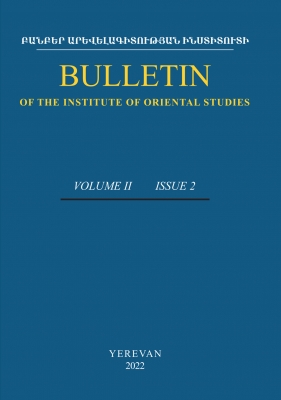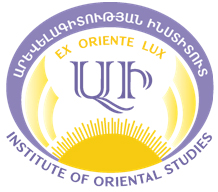Articles
- Robert Ghazaryan
ADMINISTRATIVE AND POLITICAL SYSTEM AND ECONOMY OF THE KINGDOM OF KANESHp.p 13-24
Abstract
The state of Kanesh was one of the state formations established in Asia Minor during the Bronze Age. It played a significant role in the process of formation and establishment of the Hittite state (mid-XVII century BC - early XII century BC). The city was the second center of the Hittite state after Kussara, and its territory served as a base for the further expansion of the Hittite state. It is important to emphasize that the city was also the capital and the center of the international trade network (in more than forty cities) organized by Assyrians. The state structure of Kanesh, its system of government also had an influence on the Hittite state system. All these lead us to study and explore the history of that city-state, to have an understanding of its state order, economy, and socio-economic relations.
- Aram Kosyan
IŠUWA TOWARDS THE END OF THE XIII CENTURY BC (ON THE PROBLEM OF THE GROOVED WARE)p.p 25-35
Abstract
At the end of the XIII century BC archaeological excavations carried out in various regions of Eastern Turkey have revealed a complete cultural break, thus marking the end of the Late Bronze Age (LBA) and the rise of the Early Iron Age (EIA). The main peculiarity for the new culture is the appearance of the so-called "grooved ware" which was unearthed during the excavations at numerous sites on the territory of Išuwa, a political unit well at-tested by Hittite cuneiform texts. This same ware is known also from several sites located in different parts of Eastern Highlands (eastern Lake Van basin, Tillehöyük, Lidarhöyük, Erzurum, Iğdır, etc.). To date the causes of this phenomenon are not clear. Ch. Burney and V. Sevin were the first to assume that at least in the case of the Upper Euphrates basin the transition from LBA to EIA was the result of migration from Transcaucasia. Later this as-sumption was cast doubt on by other archaeologists. U. Müller suggested that the source for the grooved ware should be looked for in Išuwa, and that later some population of this re-gion moved to the south and south-east. For the solution to this problem the author refers to the movement of the population of the Kura-Araxes culture of Transcaucasia and neighboring regions to the south-west and south which happened about 2000 years before the end of the LBA, during the termination of the Early Bronze Age I in Transcaucasia (end of the IV millennium BC). Most probably, the causes of both migrations could be the result of the so-called 5.2 and 3.2 kiloyear cli-matic events. Strikingly, the routes of the Kura-Araxes I migrants coincide with that of the grooved ware people. Thus, the suggestion of Ch. Burney and V. Sevin seem more plausi-ble than the proposals put forward by later authors. Most probably in both cases we deal with significant migrations of Transcaucasian population groups.
- Arthur Matevosyan
12 ANATHEMATISMS OF ST. CYRIL OF ALEXANDRIA AND THE CHRISTOLOGY OF THE ARMENIAN CHURCHp.p 36-48
Abstract
It is well known that the Christology of the Armenian Church is based on the Christological teaching of St. Cyril of Alexandria. Following St. Cyril, the Armenian Church confirms the invariability and perfection of divine and human natures in Christ. The hypostatic union of Christ does not lead to a change or amalgamation of natures. It admits the union of Christ with God the Father in deity and with us in humanity. Jesus Christ, the only begotten Son of God, is a perfect God and a perfect man, begotten before the ages from the Father ac-cording to deity, and for our salvation from Mary the Virgin according to humanity. And therefore, there is one nature of God the Word incarnate, revered together with His flesh in one worship. This is what the Armenian Church has believed since the 5th century to date. This article will examine the connection of 12 anathematisms contained in the letter of St. Cyril of Alexandria to Nestorius with the Christological teaching of the Armenian Church.
- Gor Margaryan
XALA, ĞALLA, QĀLĀN: DISCUSSING MEDIEVAL TAX TERMSp.p 49-55
Abstract
The purpose of the study is to explore the origin and meaning of the term խալայ - xala, to identify the peculiarities of its application in the Armenian historical milieu, and to define at least approximately the chronological boundaries when the tax was in use in medieval Armenia. Xala became known mostly from epigraphic records of Armenia, where the term is mentioned in the immunity donations, in the instructions and references to the exemption of churches from tax obligations and from taxes, including xala. The paper will address all well-known explanations of the term, along with a comparative analysis with the Georgian historical environment, with the fiscal system of medieval Georgia, and, on the other hand, based on the analysis of source studies and definition of the etymology of the term and the phenomenon, a new definition of the term and answers to the above questions related to ẋala will be proposed as a hypothesis.
- Dali Chitunashvili
A FRAGMENT OF AN UNKNOWN ARMENIAN HOMILETIC COLLECTION FROM THE GEORGIAN NATIONAL CENTRE OF MANUSCRIPTSp.p 56-63
Abstract
In the Armenian manuscripts fund of the Georgian National Centre of Manuscripts there is preserved a Gospel, which paleographically dates back to the 15th century [10:238]. The Gospel was restored in the 60s of the 20th century, and the fragments of the authentic leather cover are preserved. In the course of the restoration, it appears that two sheets of parchment used as flyleaves have been removed. The parchment fragments are horizontally cut parts of a single sheet and attract attention from both paleographical and textual perspectives. Before being cut, the size of the fragment was 320x210, but even this does not reflect the original size of the parchment sheet, since only one column survives in the fragment, that too incompletely, and the manuscript must have been written in at least two columns. In the fragment preserved today, the size of the column is 115 mm, the distance be-tween the columns is 20 mm, there are 22 lines in the column, the distance between the lines is 10 mm, the bottom margin is 110 mm, and the right margin is 82 mm.
- Khatuna Gaprindashvili
TRAVELING HISTORY OF THE ARMENIAN FOUR GOSPELS DATED TO 1686 (NCM RAR 82)p.p 64-74
Abstract
The colophons of the old manuscripts, in general, convey important information about various persons, noble families, churches, monasteries, historical facts or contemporary political situations. In addition, the colophons often allow us to trace the history of creation, composition, purpose, preservation and sometimes to follow the journey of the manuscripts. One of such books is the Old Printed Armenian Four Gospels (RAR 82) preserved in the Rare Books Room at K. Kekelidze Georgian National Centre of Manuscripts.
- Beniamin Mailyan
ILIA CHAVCHAVADZE AND THE EMERGENCE OF GEORGIAN NATIONAL DISCOURSEp.p 75-89
Abstract
The purpose of this article is to explore the history of the emergence of the discourse of Georgian nationalism and the idea of the Georgian nation. The author offers an alternative view of the reasons for the emergence of Georgian nationalism and identifies the main top-ics of the Georgian national narrative. Ilia Chavchavadze, a poet, a writer, a publicist and a public figure, is considered the spiritual father of the nation in Georgia. He is one of the key figures in the Georgian historical pantheon because he outlined the main ethnic markers of Georgian identity. He and his circle, the group of intellectuals known as Tergdaleulebi, mark the beginning of the history of Georgian nationalism. This makes him an indisputable authority for all those who call themselves Georgian patriots.
- Miqayel Martirosyan
NEWLY DISCOVERED DOCUMENTS ABOUT GRIGOR ZOHRAP’S ACTIVITYp.p 90-110
Abstract
After the publication of the monograph “The chronicle of the life and activities of Grigor Zohrap” by Prof. Albert Sharuryan it would seem that all episodes of Zohrap’s life had been revealed. Yet the study of Russian-German diplomatic clash in regard to the Armenian reforms in 1913 shows that G. Zohrap was actively involved not only in that process but he also functioned as the main negotiator from the Armenian side, a fact which remained un-noticed by historians and philologists. While the Armenian national delegation headed by Poghos Nubar was the official body representing the Armenian problem to great powers in Europe, in Constantinople the official negotiating body was the Commission of Safety of Armenian Patriarchy. G. Zohrap was one of the five members of the Harassing commission which supported the Safety commission who in the course of negotiations became the main actor. His participation in the negotiations was hidden by Russian diplomacy and by the Armenian circles and G. Zohrap himself. He was a member of the Ottoman parliament and it would be quite dangerous since the Young Turks could accuse him of treachery. The documents presented in the article deal with the meetings of G. Zohrap with the first translator of the Russian embassy A.N. Mandelstam on August 20, 21, and 24, Sep-tember 1-2, 1913 and the second translator of the German embassy Schönberg on August 30. These documents are kept in the archive of the Mother See of Holy Etchmiadzin. In the documents Zohrap’s name is missing but the comparison of documents of Great powers and memories of contemporaries comes to prove that it was he who negotiated on behalf of the patriarchy. After the end of the meetings G. Zohrap came to the Safety commission and talked about the course and results of the negotiations. His reports were recorded and sent to Gevorg V Surenyan, the Catholicos of All Armenians. The study of these documents shows that G. Zohrap had a considerable contribution in the achievement of a compromised Russian-German agreement in regard to the Armenian reforms.
- Hayk Soghomonyan
THE 1953 COUP IN IRAN AND THE ROLE OF GREAT BRITAIN IN ITp.p 111-123
Abstract
The article discusses the causes of the 1953 military coup in Iran and the role of Great Brit-ain in it. In 1951 Prime Minister Mossadegh roused Britain’s ire when he nationalized the oil industry. Mossadegh argued that Iran should begin profiting from its vast oil reserves which had been exclusively controlled by the Anglo-Iranian Oil Company. The company later became known as British Petroleum (BP). After considering military action, Britain opted for a coup. President Harry Truman rejected the idea, but when Dwight Eisenhower took over the White House, he ordered the CIA to embark on one of its first covert opera-tions against a foreign government. In 1953, Iranian armed forces, with the help of the CIA and British intelligence, orchestrated a coup that toppled the democratically elected government of Iran.
- Orazio Maria Gnerre
THE ECONOMIC TRIANGULATION BEIJING-YEREVAN-NEW DELHI: COOPERATION OR COMPETITION?p.p 124-134
Abstract
Since it is no longer part of the Soviet Union, Armenia has found itself in the position of being able to choose its partners independently. This was largely determined by proximity relations, by historical ones with Russia, and by the places where the emigration of Arme-nia’s own people took place. Beyond that, it is placed in conditions of choice between co-operation with some actors rather than others. In this sense, Armenia has started dialogue and trade relations with two Asian giants, China and India. The article proposes to recap the relations between these countries, paying attention to the factors that could allow a triangu-lar cooperation rather than a competition.
- Mushegh Ghahriyan
UNDERSTANDING OMAN’S POLICY TOWARD REGIONAL CONFLICTSp.p 135-151
Abstract
The study of Oman’s foreign policy attracts scholars because of its unique features. It un-doubtedly differs from the foreign policies of other countries in the region. This paper fo-cuses on Oman’s policy in three cases of regional conflicts: the Syrian war, the war in Yemen, and the crisis in Qatar in the context of regional changes and Saudi-Iranian rivalry. Oman pragmatically manoeuvres to mitigate threats emerging from the crises and wars in the countries of the Middle East.
- Artyom Tonoyan, Artem Davydov
ON THE LEXICAL EVIDENCE OF THE CONCEPT OF "LEADER" IN MIDDLE PERSIAN AND ARABIC LANGUAGESp.p 152-160
Abstract
In New Persian (hereafter NP) there are more than two dozen Arabic borrowings, attested in different dictionaries and partly still using today for the concept of "leader" [8], while most of the words for the same concept in Middle Persian (hereafter MP) are of Iranian origin. The present article introduces and examines the lexemes attested in Middle Persian and Arabic with the meaning "leader, leader, commander". The choice of the Middle Per-sian language is due to the task of showing the features of the public perception of the con-cept "leader" and its expressions at the linguistic extent in Sassanid Iran, still free from strong Arab influence. On the other hand, the choice of Arabic is due to the fact that it shows the enormous influence that the Arab world had already in the post-Sassanid period on the Iranians' perception of the concept of "leader", and, consequently, the Arabic lan-guage itself, in the level of linguistic thought, in the face of Arabic borrowings to denote the concept of "leader" in NP. The Arabic loanwords in NP, used for the concept of "lead-er", are presented in the authors' previous paper [8], because of which the present examina-tion is limited in the presentation of the denotants of the concept of "leader" only in Sasa-nian Middle Persian and Arabic. The lexical material of Middle Persian is extracted from the well-known dictionaries of D. N. MacKenzie [18], H. S. Nyberg [21], and D. Durkin-Meisterenst [10], and Arabic from the dictionaries of X. Baranov [3] and E. W. Lane [17]. In addition, Arabic loans in NP are written out from the dictionaries of ‘Amīd [1], Mo’īn [19], Dehxodā [9], Steingass [24], Rubinčik [22] etc. Four lexemes of Iranian origin, i.e. parwānag, pēšar, pēšōbāy and sālār, attested in Middle Persian with the meaning of "leader" were subjected to etymological examination. Simultaneously, 26 Arabic words in the same meaning, the majority of which were also borrowed in Persian, are presented.
Scientific Life
- Monika Mirzoyan
INTERNATIONAL CONFERENCE “THE CAUCASUS AT THE CROSSROADS OF INTERNATIONAL TRADE AND CULTURAL EXCHANGE (FROM ANCIENT TIMES TO THE PRESENT)”p.p 163-166
Book Reviews
- Hasmik Hmayakyan
ARAM KOSYAN, "THE HITTITE KINGDOM (POLITICAL HISTORY)", YEREVAN, 2022, COPY-PRINT PUBLISHING, MAPS, NOTES, BIBLIOGRAPHY, INDEX. 252 P., DOI: 10.54503/978-9939-9012-5-1p.p 169-172
 English
English Հայերեն
Հայերեն











